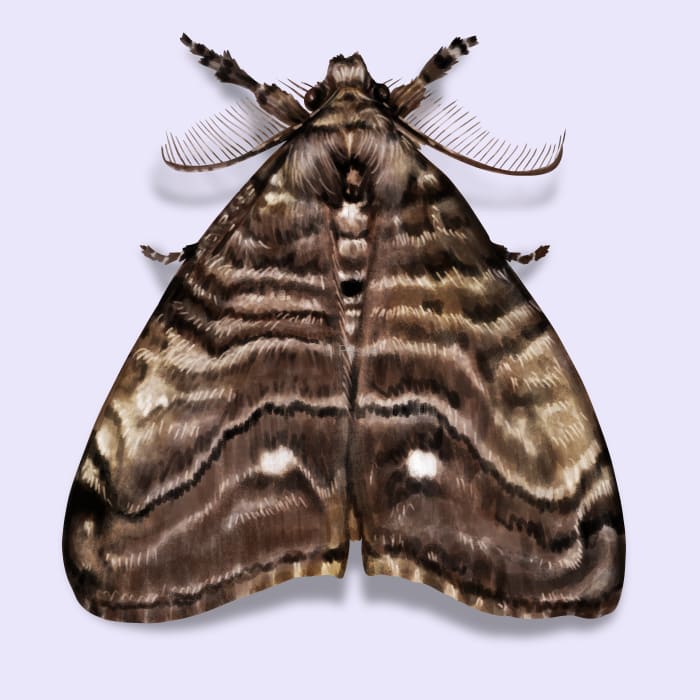How to identify and get rid of tussock moths

The punk rockers of the moth world
If there were ever an insect with a hairstyle, it would have to be the tussock moth. These fuzzy moths aren't your typical lawn and garden pest but can be devastating to the right homeowners with trees in their yards.
As caterpillars, they have tufts of hair that are often itchy and irritating if you brush up against them. This acts as a defense mechanism against being eaten. That's where they get the name "tussock" from.
Tussock moth females will lay their eggs on trees and shrubs, including oak, bald cypress, cherry, hackberry, willow, and maple tree. Some years will have an abundance of tussock moth caterpillars, while other years will hardly see any.
The females have tiny wings and can't fly. She will lay her eggs on her cocoon and cover them with her itchy hairs. When the eggs hatch, the larvae will spin a silk web and use it to sail away to a new host.
There are around 30 species of tussock moth in the US, with the most destructive being the gypsy moth.
How to identify tussock moths
Tussock moths are small, brown to gray moths with a fuzzy body. The males have fully developed wings, while the females have underdeveloped wings and can't fly. The males will have large, feathery antennae that lay flat when they land. The hairs on the end of the moth's abdomen can often cause rashes or an itch.
The caterpillars are often a bit more colorful. The most distinguishing feature is the two clumps of pencil hairs on the front and back of the caterpillar. They will also have fur clumps of fuzzy hair on their back. It's a pretty radical hair-do for such a little guy!
How big are tussock moths?
Tussock moth caterpillars can grow up to 2 inches long, while the adult moths have a wingspan of about 1.5 to 2 inches.
What other pest looks like a tussock moth?
Many moths might look similar to tussock moths and are sometimes called tussock moths. These include tiger moths and lichen moths. Additionally, the family of noctuid moths might also look like tussock moths. The reason this is so is because scientists only recently changed how these were classified. They all used to be in the same family at one time because they all look alike!
Sometimes oleander caterpillars might be confused with tussock moth caterpillars, which also have tufts of hair but lack the oleander caterpillar's distinctive orange color.
Where do tussock moths live?
They live throughout the United States and feed on various trees, shrubs, and herbaceous plants. The most likely place to find them is in forested areas.
How to get rid of tussock moths
It can often be difficult to eliminate tussock moths when it is a year of abundance. If you don't want to spray insecticides all over your trees, which isn't recommended, here are a few strategies to control them:
- **Physical removal: **Wear gloves and gently pluck caterpillars or egg masses off plants.
- Pruning: Cut off infested branches to control the spread.
- Encourage natural predators: Birds, beetles, and other insects can help keep their population in check.
- Barrier methods: Wrap tree trunks with burlap to catch caterpillars trying to climb up.
Control is often difficult because the moths can easily move and distribute from outside trees and sources.
To protect your home from moths, consider Pestie. We have a DIY solution that uses the same ingredients the pros use! Get it delivered automatically to your door when you need to reapply and keep your home protected all year.
Treat tussock moths with Pestie
If you're still having trouble keeping tussock moths away, the best option is to use a pro-grade, effective pest control solution like Pestie.
Pestie is a do-it-yourself pest control solution that's specially designed to keep tussock moths and other pests away from your home.
With Pestie, you can rest easy knowing that your living space is protected and free of creepy crawlies. And the best part? It's designed for people, pets, and the planet, so you can say goodbye to harsh chemicals and hello to peace of mind!
- Save hundreds compared to traditional annual pest plans
- People, pet, and planet-friendly
- Pro-grade customized formulas
Quick facts
- Scientific name
Lymantriinae
- Other common names
Tussock Caterpillars
- Colors
Brown, white, gray
- Life span
One year
- Diet
Leaves of trees and shrubs
How dangerous are Tussock Moths?
Low danger risk
While tussock moth caterpillars are not harmful to humans, their hairs can cause skin irritation or allergic reactions in some people. Plus, they can significantly damage trees and plants.
Tussock moths have itchy hairs, not just as caterpillars or moths. When they pupate, they still keep their hairs to ward off predators.








